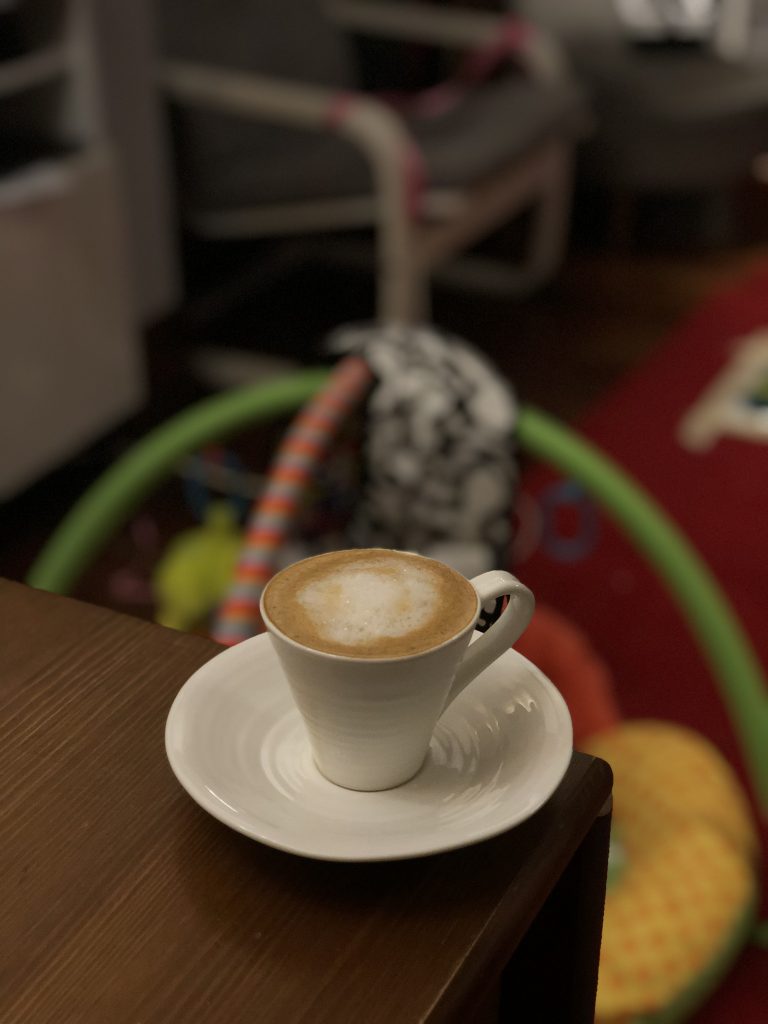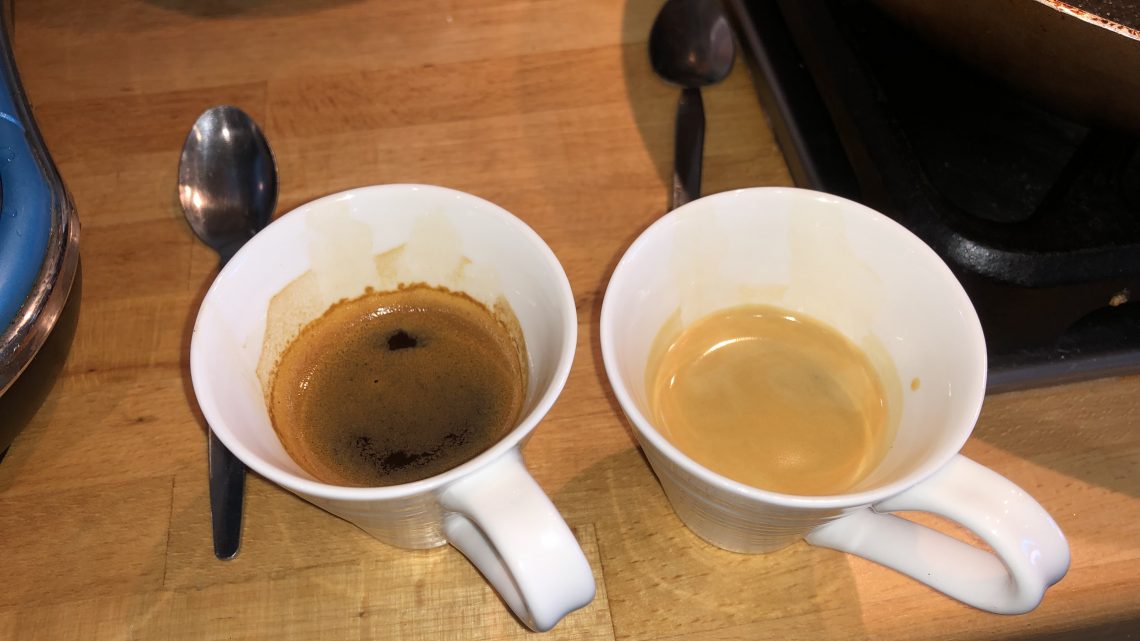
9-bar, finely ground bean water
Sounds nice doesn’t it? No? How about medium-dark roasted coffee beans grown at high altitude, finely but consistently ground into a light powder, tamped tightly into a ~18g ‘puck’, pre infused with near-boiling water and then perfectly extracted by (optimally) high pressure water for roughly 30 seconds to make a tiger-striped, aromatic, crema-topped velvety 40g cup of not too sour, not too bitter coffee to brighten up your day and bring joy to your senses? That sound a bit better?
Today, I made a semi-decent cup of coffee.
It wasn’t the best coffee I’ve ever had but it was the culmination of months (and to an extent, years) of research, preparation, skill-honing hobby enthusiasm. It was the point at which I realised that the recent obsessing over espresso making skills and tips videos and online communities has yielded the cornucopia of all hobbyists: progress.
I haven’t always cared much about coffee. In fact, I was probably fairly late to the whole British ‘hot drinks’ thing that failed to permeate my teenage years. Looking back, it was perhaps the first signs that my now-wife might be something more serious than just a ‘university girlfriend’ when I found myself purchasing an anti-allergy duvet (I should have seen the signs, right?!) and asking to be given a teapot and a cafetière for my birthday so that I could appropriately entertain her. (I failed on many levels at being a late-teen, early twenties university student, didn’t I?!). This cafetière ended up fuelling me through my later years at University, even after that girlfriend had moved back to London to study teaching while I finished up my masters. I wonder what happened to her 😉 That cafetière was certainly a feature of my dissertation in my final years. I remember working late, late into the night finding the sweet spots of my post-teenage focus hours in whatever way I could capture them.
In fact, that cafetière pretty accurately summed up my future relationship with coffee: I obsessed about it, treasured it, and eventually had to cut myself off from it because I feared I’d become dependent. This is a cycle I have repeated a few times throughout my 20s and 30s, and while I feel I understand it better now may still end up repeating again. Specifically, I gave up coffee for a couple of years when we were trying for a baby and then to show solidarity to my pregnant wife (oh yeah – that’s what happened to her) when she chose to cut out caffeine for the baby’s health. I also cut out coffee when I realised that I was using it as a means to consuming increasing volumes of sugar. But there have also been periods when I just haven’t been that bothered about it. It certainly isn’t a life-long obsession.
I do regard the process and consumption in high regard though. I have very fond memories of drinking coffee at weekends in a coffee shop in Bristol (during an otherwise fairly low part of my life). In fact, one day I will finish the novel I started writing pre-dragon that was based, at least partly, in that coffee shop. I learnt to savour the taste and smell but also the experience of relishing a coffee as an activity in itself, not just an accompaniment to something else. I could enjoy the juxtaposition between the calmness of the relaxation against the buzz of the caffeine stimulating the synapses (as well as the heart!). I still very much enjoy treating myself to a coffee when I have the time to really appreciate it, even if that is less and less the case.
What I have found more recently though is that the process of making the coffee can be as much a part of the ritual and experience as just consuming it. We’ve had a entry-price espresso machine for something like 12 years now and I always used to pine over the expensive, fully automatic coffee machines that could do everything from grinding the coffee to frothing the milk before you’ve even woken up. It was not until my good friend Alex (as in the guest blog Sri Lanka post, Alex) started bestowing me with an appreciation for mindfulness, that I realised that I actually found great pleasure in the methodical process of making coffee, not just consuming it. As such, I now pine after more and more manual ways to make coffee and dismiss the appeal of having even the fanciest automatic coffee makers.
I do not have a particularly refined palette when it comes to appreciating coffee. In fact, I have, as I stagger blindly through the stages of understanding coffee creation, wondered whether I really ‘like’ the taste of coffee at all?! I certainly remember my first experience of drinking espresso at University. By this point I was a semi-regular filter coffee drinker and I remember they remodelled our main campus canteen to have a coffee/sandwich bar. Drinking espresso seemed like a cool thing to do and it was already a principle ingredient in the Americanos and Lattes I would occasionally drink. So why not try the primary ingredient itself? Somewhat encouraged by my friends, I bought an espresso and tried to drink it with all eyes watching. I distinctly remember hints of ashtray and leather handbag and absolutely nothing redeeming about it at all. Interestingly, one of the main encouraging friends – still one of my absolutely favourite people in the world – has just bought himself a decent (not the brand – we’ll come on to that…) espresso machine for his home. Oh how the world goes full circle.
The various lockdowns associated with COVID probably re-prompted my coffee interest. Unable, or unwanting, to buy coffees from coffee shops I found myself wanting to make more at home. The fact that this coincided with me becoming a father for a second time, especially considering the first child had yet to really master the whole sleeping thing, was, I’m sure, a complete coincidence. I would typically make a something in between a cortado, a flat white and a small latte. Too much milk to really be called a cortado (where the ratio of espresso to milk would typically be 1:2) and too little to be a latte by the chain coffee shops that serve coffee like you’re eating popcorn. But the steam wand on our espresso machine is bubble obsessed so all of my drinks are far too frothy and bubbly to be a flat white or the like.
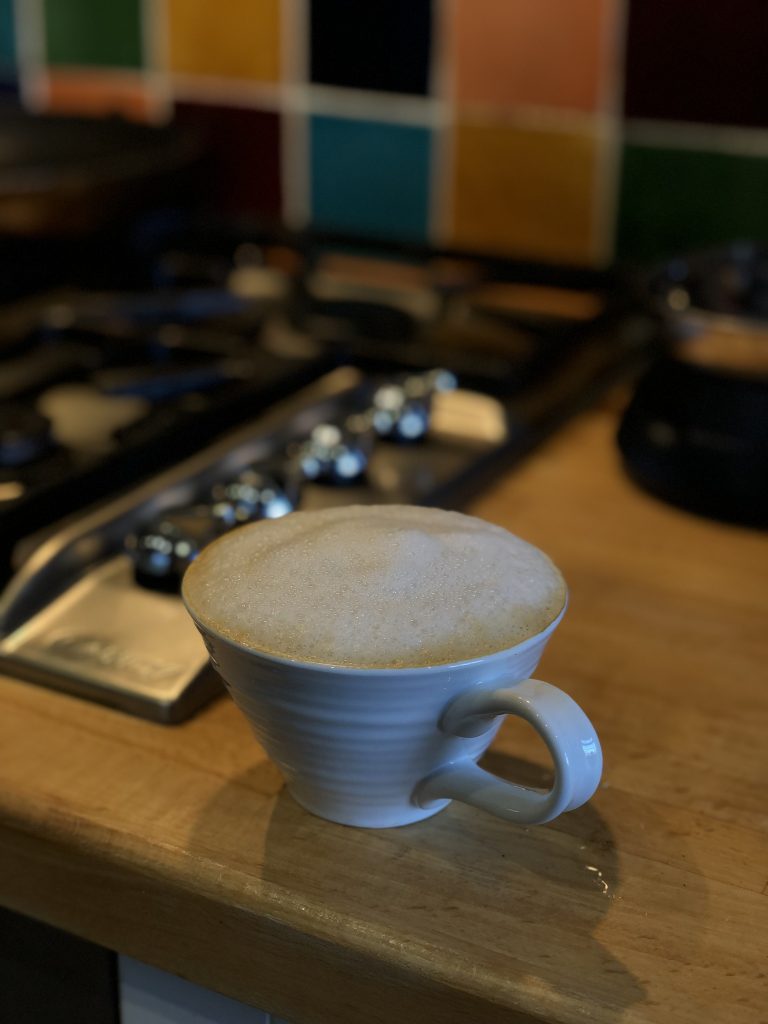
For a long time I would make variations of this type of coffee (milkier decaf versions for my wife and just frothed milk for Piglet) when I fancied it. It takes far longer than it should (part workflow, part user competency) and they taste OK. My wife bought me a coffee grinder quite a few years ago and I use that because I love the smell of ground coffee but in truth I’m not sure it made the coffee much better. I never quite worked out what settings to use it on and I realise now (in hindsight) that it actually made my coffee quality much more variable. Some days it was good, others really disappointing.
And so by the powers of those scary high-tech companies in California and their viewing habit algorithms, I ended up watching a video by a guy called James Hoffmann one day – specifically about how to steam milk. I think I’d just made about a pint of milk froth from about a thimble of oat milk and was wondering what I was doing wrong. His video had a very clear narrative of how you want to bring air into the milk quickly at first and then use the steam to whisk the bubbles smaller and smaller. And so I tried to do the same thing, failed miserably, and started down the toxic (but exciting) road of really that you just need to spend loads and loads of money on home barista equipment!
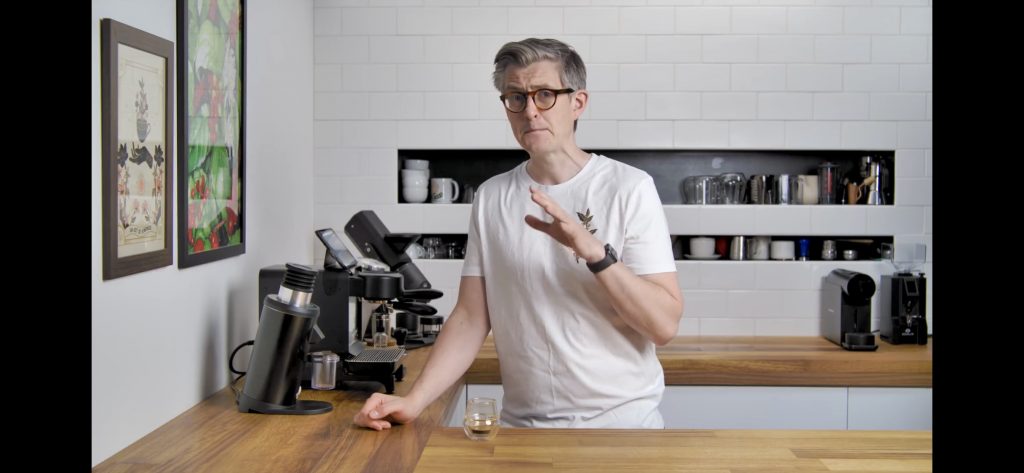
In terms of steaming milk, it turns out that what I have is called a paranello wand; a wand specifically designed to make fluffy milk for cappuccinos when you don’t necessarily have enough power in the steam to agitate the milk sufficiently. It does this by having a hole in the top that sucks in air along side the steam which helps to make bubbles in the milk. The problem is that you can’t turn the air supply off so once you’ve got enough volume and you want to use the steam to whisk the milk and/or provide heat, as per the tips from James Hoffmann, you just keep getting more and more bubbles… The solution is a steaming wand attached to a more powerful boiler. The problem is: once you start looking for things to upgrade; the list gets very long very quickly.
Having enjoyed the steaming milk video, I subscribed to his channel and started watching more of James’ videos. He reviews various bits of kit, looks at ways you can manually modify or ‘cheat’ with using bits of kit in ways they weren’t originally designed in order to come up with a better end product. He has his own technique for making coffee in a french press. He explains the science of what caffeine does to the body. He reviews £1500 hand grinders but then tells you which <£400 espresso machine is the best. He also gets annoyed with kit that should work but doesn’t (scales that don’t sync to bluetooth when they should, Amazon making cheap own-brand espresso machines that just fire a hole through the coffee grounds etc…). But more generally, he gives you a real appreciation of the art form of making coffee and why and how we’ve ended up consuming coffee in the way that we do (in the ‘West’, for want of a better phrase). He’s very clear that coffee preferences are a very personal thing while being quite particular about why some things should be (and his opinion, are) better than others.
Having followed his videos, I then found myself in the questionable territory of joining Facebook groups of coffee, and specifically espresso, enthusiasts. It’s quite astonishing how far some people have gone down the rabbit hole of seeking improvement in their espresso making set up. But also the range of appliances and kit that people aspire to in order to heighten their coffee appreciation: Conical burr grinders costing hundreds of pounds to maximise the uniformity of their grounds for espresso. Even more expensive flat burr grinders for extra clarity on ‘pour overs’. Espresso machines costing thousands of pounds to regulate temperature control, flow rate, pre-infusion, water pressure etc… All in the search for optimal extraction. At first impression, it’s quite easy to believe that there’s an element of ’emperors new clothes’. Surely coffee is just coffee? But actually, having made some of the most basic improvement steps myself, I can see how much scope there is for improvement. And even if a home espresso set up costing £10,000 might not be 100 times better than the 12-year old set up I have at home, it must be tempting to reach for the next level or improvement if you can afford it – even if the incremental cost for that minor improvement sounds astronomical.
In terms of the basic improvements I’ve done myself, the first thing I did was buy some reputable freshly roasted coffee beans. So recently roasted that the let me know the day that they were going to be roasted and shipped them to me only 4 days later! In danger of sounding like a true sycophant – the company I bought them from is a London coffee-roasters called Square Mile. Who just happened to be co-owned by a certain James Hoffmann. However my justification for buying them weren’t just his name. There is a coffee shop in London called Kaffiene which is one of several highly regarded Australian-owned coffee specialist cafes in London. A friend and I went there a few years ago and were really impressed and I noted at the time that they used something called ‘Red Brick’ coffee. When I saw that this was the default espresso coffee beans from Square Mile and that this was James’ company; it seemed too good an opportunity to miss.
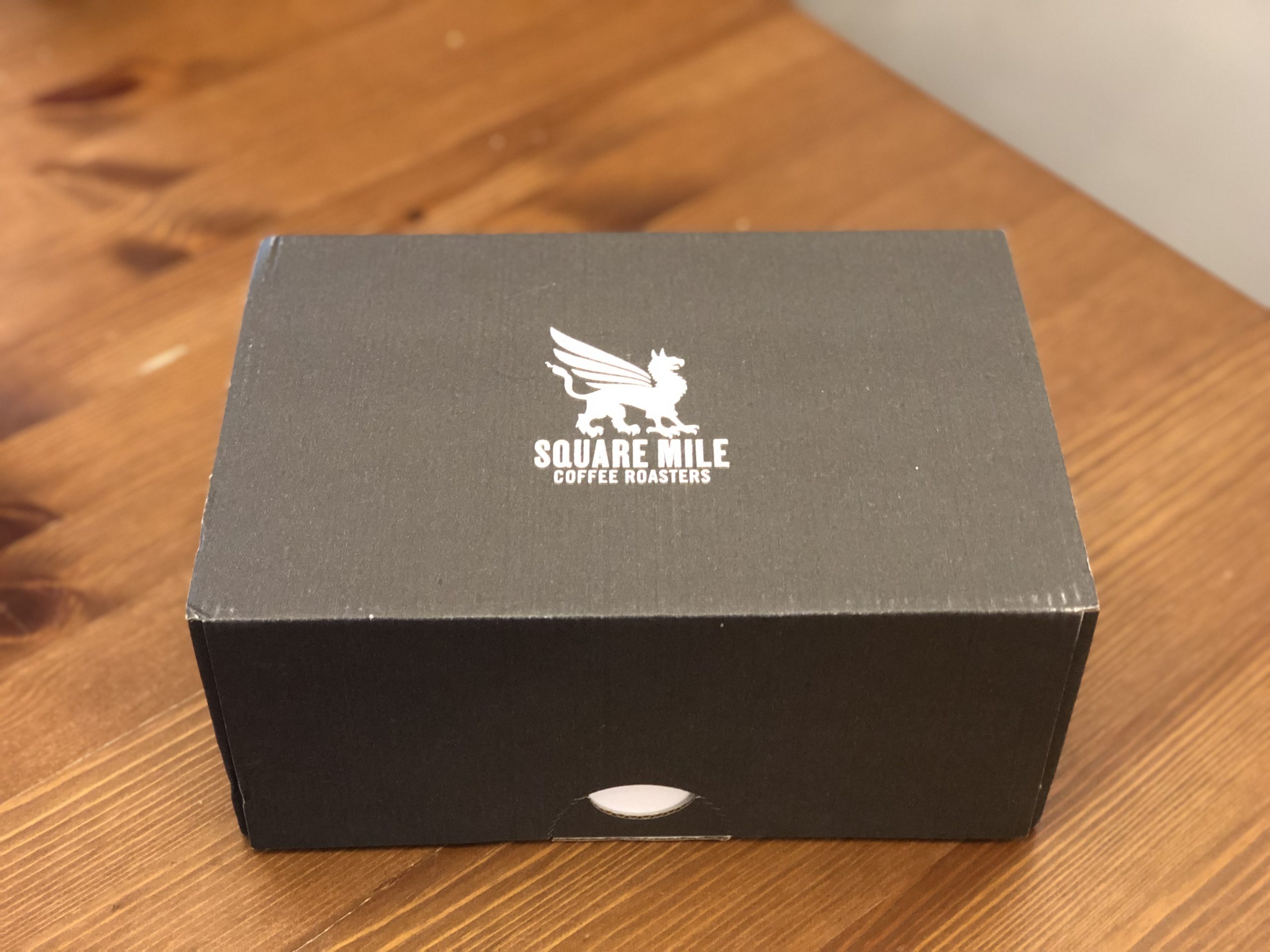
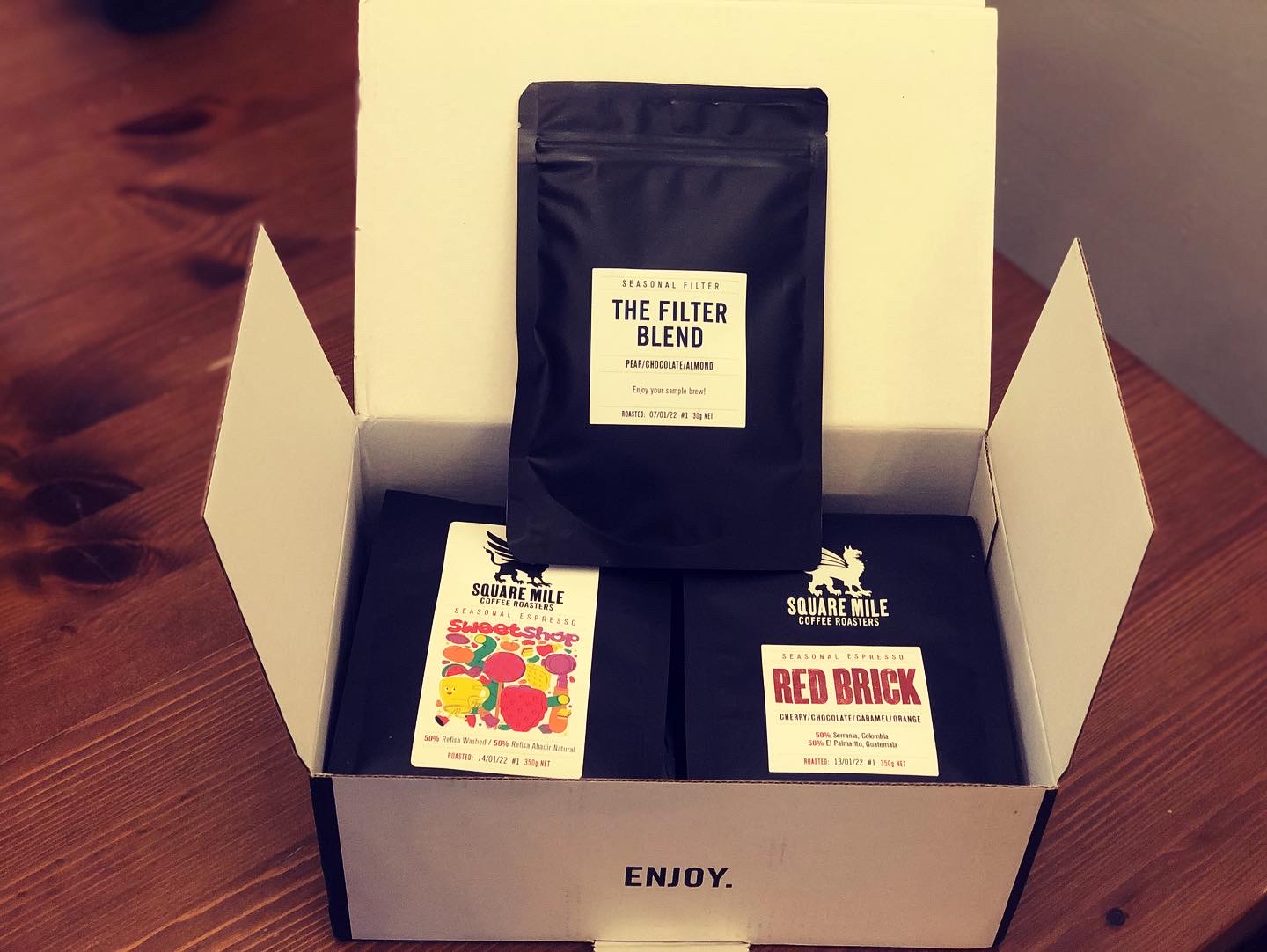
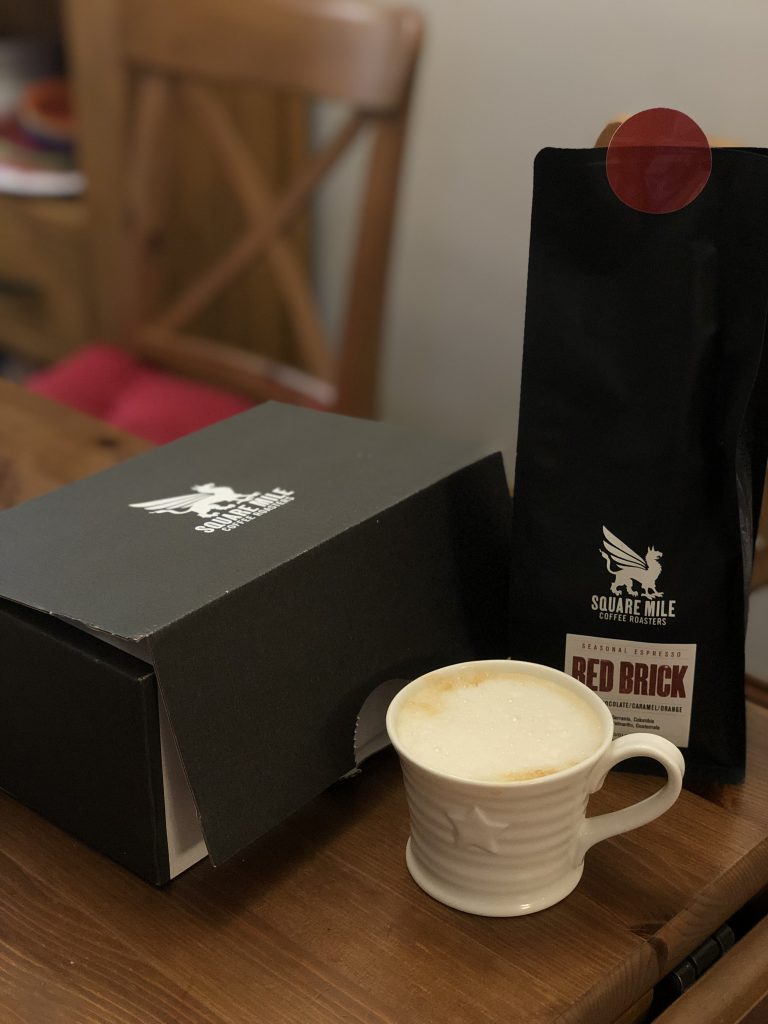
However, the honest truth is that I didn’t see material improvements using the Square Mile coffee. I found it very difficult to get a consistent outcome. Some shots seemed to labour and others came out way too fast given that I was ideally looking to get about twice as much coffee as the weight of grounds I was putting in in approximately 30 seconds (the widely considered starting point for an espresso recipe). One of the things I quickly learnt from the Facebook groups I’d joined was that my coffee baskets (the bucket that the ground coffee sits in before you press the water through it) are pressurized or ‘double wall’ baskets.
I’d heard of double wall baskets before: they usually have only 1 tiny hole for the coffee to escape through which means that the pressure on the coffee is created by the lack of flow. They are generally used for pre-ground coffee that isn’t usually fine enough to make ‘proper’ espresso (most pre-ground coffee isn’t usually fine enough). The pressure created by the lack of flow makes up for the pressure that you would otherwise create by trying to force the water between the very fine grounds in a basket that has lots of holes. My basket has lots of holes but it’s an unusual construction with a spring loaded valve on the bottom that means that it requires high pressure to flow through. What that means is that it wasn’t really the fineness of the grounds that was dictating how fast the coffee flows.
A bit of internet searching led me to find that I can buy single wall baskets that fit my espresso machine despite it being a relatively unusual size. Most portafilters are 58mm diameter but mine are only 51mm. The first one I got was super cheap from eBay (I think they cost £5 including delivery?!) but turned out to be pretty rubbish. The holes were far too big so while I could control the pressure by changing the grind settings; what I got was a sludgy muddy coffee with lots of bits in it. It took me a little while to realise that I wasn’t going to make any more progress with that basket.
I then found that Delonghi (the makers of my espresso machine) do their own parts and also sell single wall baskets so I ordered one from them. Unfortunately they had stock issues and it said it wouldn’t arrive until March but then by luck I got an email saying it had dispatched only a couple of weeks later. It seemed to take forever to arrive and I would check every day whether anything had arrived in the post for me. Once it did arrive the difference was clear – the holes were so much smaller than the first one.
It took a little while to ‘dial it in’ (the iterative process of adjusting the grind size so that you get the right sort of resistance to be able get that 2:1 ratio in ~30 seconds. Usually when dealing in new beans you’d already know the dose (the weight of beans you’re putting in) and the only variable you’re trying to change is the grind size. But in this case I realised I was overloading the basket by trying to get up to the 18g you might expect to see in for a double shot on a 58mm portafilter and had to reduce down to about 15g which in turn affects the flow rate and grind size etc… I still haven’t managed to get the settings exactly right; the espresso I claimed to be ‘semi-decent’ at the beginning of the post was still slightly too slow (a very long pre-infusion meant I got to close to 40 seconds) but it tasted good and wasn’t too bitter (a sign that an espresso has taken too long to brew; it’ll be sour if it’s extracted too quickly).
It felt like a tiny but huge achievement – even if I had no one to celebrate with at the time. I had made a coffee that I liked and made it in my own way (or at least felt like it was in my control). The trick now will be to see if it’s repeatable and whether I can hone it any further. I’m certainly seeing that I’m getting to some of the other limits of my humble home set up. Many people on the Facebook groups that I’m a part of would say (and have done!) that my grinder just isn’t up to scratch for home espresso. By getting a variety of grind sizes (because it’s not particularly accurate), I’m getting a variety of grounds that all extract at different rates. That effectively means that even if the shot overall is ‘dialled in’, there are some grounds that are over extracted and some that are under; meaning I get slightly sour and bitter tastes in the same shot. Also it is a ‘step’ grinder which means that you only have a finite choice of grind sizes. At the espresso end of coffee grinding it’s quite easy for one setting to be too fine but the next setting to be too coarse and there’s nothing you can do to get between the two. I have been pining after a very well reviewed single dose, low retention conical burr grinder called the Niche Zero which seems very popular for people at the same stage of me in terms of interest and commitment. That said, I think it probably is about 10 times the price of the grinder I’m currently using.
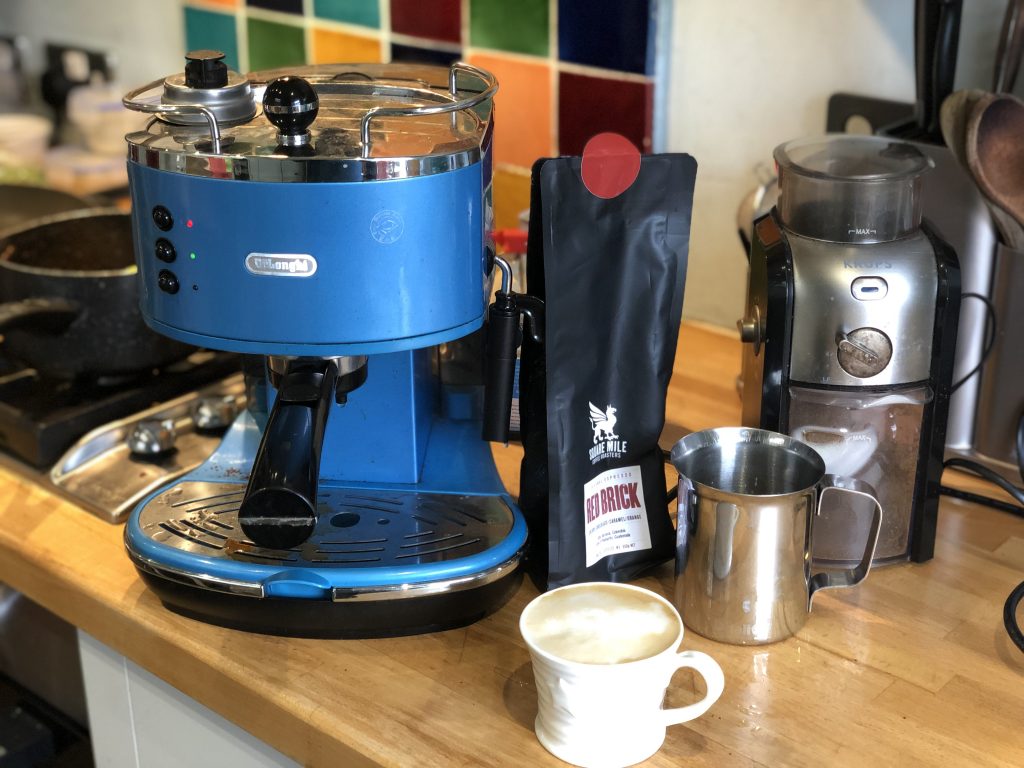
The next issue I’d like to resolve is the steam wand. I just don’t think my current machine has the power to froth milk how I’d like to get it, even if I could replace the paranello wand. Naturally that would mean replacing the whole espresso machine (what a shame) and then the range of what you might want to get gets very wide. Sage make some pretty good machines at the lower end of the cost range although hardcore espresso aficionados tend to scoff at them a bit. But I’ve read a lot of people who have been very happy with the Sage Bambino Plus as an entry-level proper espresso machine. All of this probably needs to wait until we’ve moved house though – or at least it is a misplacing of my priorities to think these are things that need sorting more urgently!
I can see why it’s a slippery slope once you start though. Now I’ve got a taste (no pun intended) for what it’s like to have more control over how you make your own coffee I’m very temped to experiment more with the all the subtle differences you can start to appreciate once you’ve got the basic processes working correctly. I’ll try not to get to boring about it (but crikey if you’re still reading I’m guessing you must be at least a little bit interested!) but there are so many aspects I’m keen to at least see if I could appreciate:
- Many people trying to improve the quality of their extraction use a bottomless portafilter so that they can see the coffee emerging through the filter. It enables you to see whether it’s extract symmetrically or whether there are parts of the puck (the name for the block of coffee grounds once it’s been tamped into place) that are flowing faster than others. From what I’ve heard it can be a bit messy (especially if it isn’t working correctly) but it’s a great way to see if you’ve got channelling. Channelling is when the high-pressure water finds a weak spot in the puck and forces open a crack that all the water then rushes through – it means much of the puck never gets extracted and the part surrounded the crack gets over extracted.
- There seems to be quite a partisan divide between people who like flat burr grinders and those that like conical burr grinders. Conical burrs tend to produce a more typical ‘Italian’ style espresso and are ofter preferred by those who like medium to heavy roast beans. From what I’ve read, you get more texture and thickness to your espresso with them but flat-burr grinders tend to have greater clarity. At risk of sounding incredibly pretentious, this clarity seems to reflect the preferences of “Third Wave Coffee” fans who are looking to get the particular tasting notes of highly specific single-origin beans from specific locations (even farms) around the world. To get this you need to roast the coffee more lightly and grind it very precisely. It’s also often made as a pour over rather than an espresso but it’s not an either or as far as I can tell.
- Following on from Third Wave Coffee and lighter roasts, many suggest that you need slightly higher temperatures to get the best extraction from light roasts (say 95oC) where as medium to heavy roasts need lower temperatures (88-92oC). High end espresso machines will let you change the brew temperature as a setting.
- It also transpires that coffee scales are quite an important part of the process and you can buy ludicrously expensive ones to do a variety of jobs. The key points of an espresso scale is that it needs to be slim enough to fit under your espresso cup and the group head (where the coffee comes out) when sitting on your drip tray and it also needs to measure to a fairly high granularity (typically 0.1g). The more expensive ones have built in timers and even bluetooth to connect to apps for various data logging and profiles. However, I’ve yet to see a review that really sells the benefits of the higher-end functions.
- Finally, people use a variety of techniques to improve the puck prep before the espresso is pulled. This ranges from spraying a small amount of water on the beans to avoid static build up during grinding (called RDT – Ross Droplet Technique – whoever Ross is), to using a set of pins to break up any clumps in the coffee grounds and make a more uniform distribution (called WDT – Weiss Distribution Technique). I’ve tried WDT and didn’t find it made much difference but I suspect that’s because I’ve had bigger obstacles to overcome in my process to date. You can buy specific tools for this but a lot of people seem to just use pins/acupressure needles in a cork.
- At the very high end of espresso process control; there is a company called DecentEspresso that make espresso machines that look like something Apple would do if they tried to enter the market. The machine comes with a large tablet screen that profiles all of the various variables across the shot (flow rate, temperature, pressure) and lets you program a variety of weird and wonderful time-phased settings to get it do pretty much whatever you want. Granted prices start at about £3000 but it gives you a level of control you’re unlikely to see on many other machines.

Coming back to Third Wave Coffee – the term generally refers to a movement which are after not just great quality but ethically supplied sustainable coffee. The consensus seems to be that the first wave was the rise in commoditised coffee from pretty much 1800 onwards (I’ve seen suggestions that the first wave began in the 17th Century and also the 1960s so there’s a bit of a wide reading on this) but think of it as the rise in coffee as a internationally traded product including the emergence of instant coffee. The second wave seems to be pretty much attributed to Starbucks and the boom in chain-store coffee shops that exploded from the 1970s onwards. Here the emphasis was on conveniences and flavours/syrups and the concept of coffee as a social cultural experience. Little initial emphasis of the sustainability of the supply chain and distinctive coffee probably more important than pure quality. The third wave started around the turn of the millennium and grew out of a dislike of the commercialism over quality of coffee and disregard for the exploitation in the supply chain. Speciality coffees emerged that were higher quality and coffee was offered as a combination of education, knowledge, and hospitality. These coffees tended to be sweeter (naturally rather than containing sugar), more complex, and have much more distinct tastes. For me personally, having never really experienced Third Wave Coffee, I tend to think of it like fine dining or fine wine: I would love to try a 15 course tasting menu from the Fat Duck down the road in Bray – I would no doubt get to experience flavours and sensations I would never normally experience – but it’s not what I would expect to have every day.
Well I will take it as a sign that I’ve had too much coffee that I’m still up and writing this nonsense. So I’ll leave it there. But I’d be very interested to know if any of you have gone through a similar journey or are tempted to. A few people reached out to me on the back of my last post where I mentioned it so I’m certainly not completely alone! May your bean juice be perfectly extracted!
Toodlepips X
